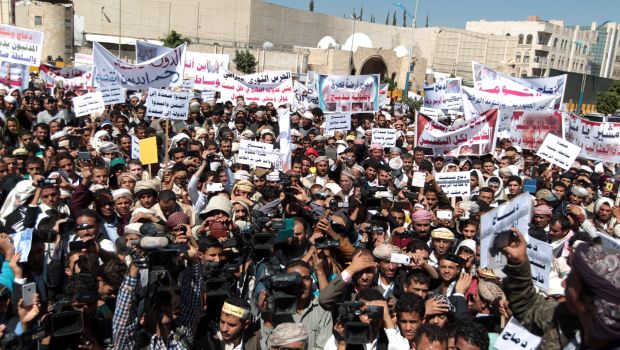
Yemenis protest outside the home of President Hadi against the fighting between the Shi’ite Houthi movement and Salafist militants in the northern town of Dammaj on November 2, 2013, in Sana’a. (AFP PHOTO/ MOHAMMED HUWAIS)
The deputy chief of the National Dialogue, Yasie Al-Ra’ini, told Asharq Al-Awsat that “the biggest point of contention at the conference is the Southern issue,” adding that “solutions were found for a number of issues which were discussed within the 8+8 and the Group of Sixteen teams.”
Delegates at the conference, which was set up to resolve Yemen’s ongoing political and economic problems in the wake of President Ali Abduallah Saleh’s ouster in 2011, previously agreed to create various subcommittees to examine hot-button issues including the demands for greater autonomy or secession by Southern Yemen.
The two halves of the country were separate states prior to unification in 1990.
Ra’ini added that “despite the differences, we have not reached a dead end . . . at the conference, and all unresolved issues come from outside the conference.” He said the issues related to the Southern problem revolved around the issue of governorates after an agreement on the adoption of a federal system and recognition the grievances of the Southern Yemenis in relation to the 1994 war.
He also said the committee studying the issue of the unstable province of Saada presented a report to the conference, which will be discussed despite remaining reservations by some committee members on some issues.
In another development, a team appointed by President Hadi has continued attempts to arrange a ceasefire between Sunni Salafists and Shi’ite Houthis in the northern city of Dammaj, following reports of the on-going bombardment by Houthis of Salafist areas.
The envoys held meetings with Salafists on Wednesday regarding a new ceasefire proposal, which had already been approved by the Houthis.
The envoys are seeking approval for the deployment of Yemeni military units to the area as peacekeepers, which was agreed by both sides as part of the ceasefire agreement, which the Salafists have accused the Houthis of violating.
Violence broke out between the two sides in the town—located in the province of Saada, on the Saudi border—after Houthis accused Salafists of stockpiling weapons and recruiting foreign fighters in preparation for an attack on them. The Salafists deny the claims, and say that foreign nationals in Dammaj are religious students.
